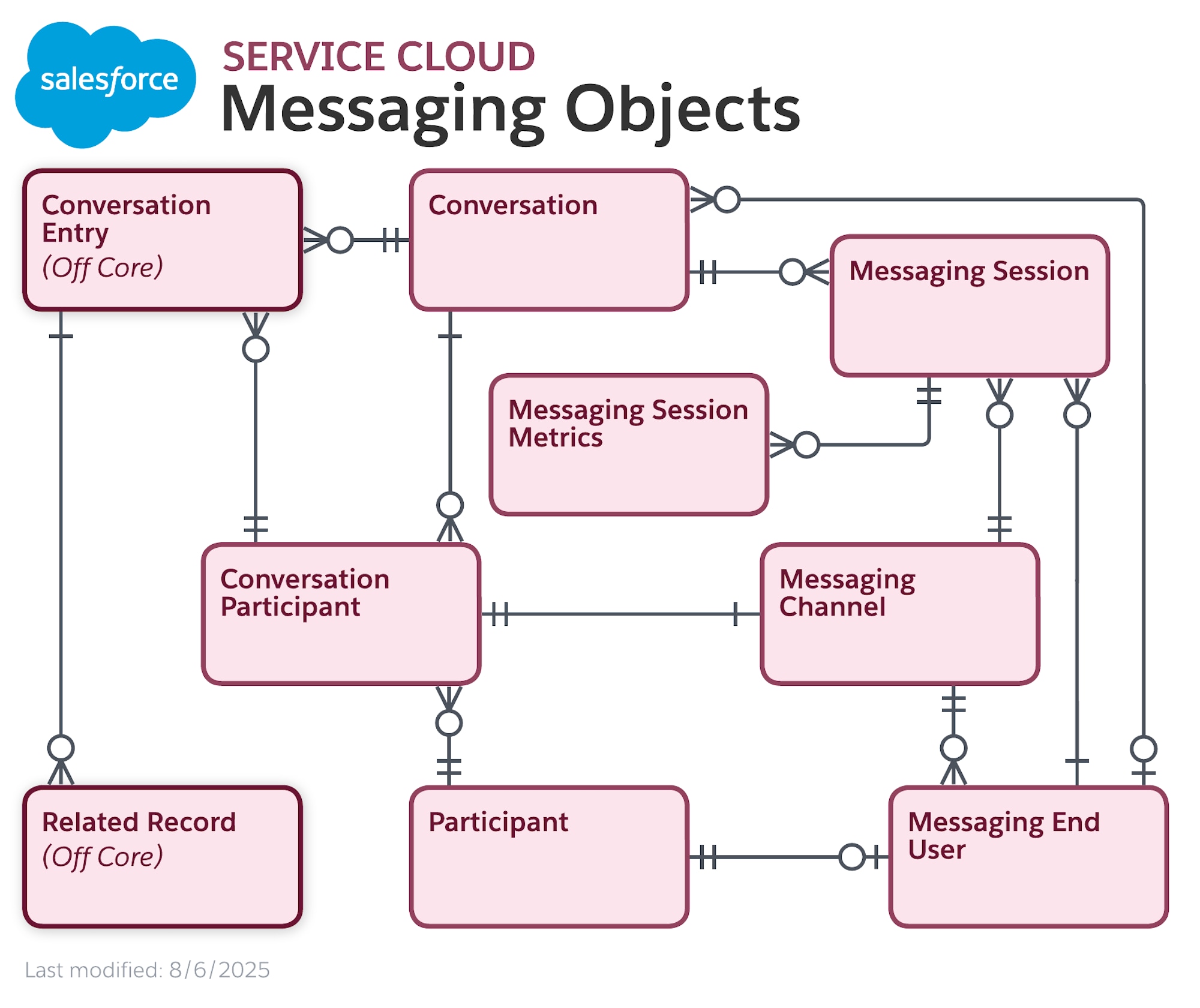Messaging Object Model
Salesforce Enhanced Messaging lets your customers interact with your business across a variety of channels, including web, mobile, and third-party messaging apps. This document provides an overview of the data model used to store information about Messaging conversations, participants, and message content.
This guide explains how your Messaging data is structured and shows you how to work with it effectively across Salesforce tools and integrations.

Storage Location: On Platform
Schema: MessagingSession Standard Object
A session with a messaging end user that occurs on a Messaging channel. Manage messaging sessions on the Messaging Sessions tab or related list.
Storage Location: On Platform
Schema: MessagingChannel Standard Object
Description: Description: A Messaging Channel represents a communication channel that an end user can use to send a message to an agent. A communication channel can be an SMS number, a Facebook page, or another supported messaging channel.
Storage Location: On Platform
Schema: MessaginSessionMetrics Standard Object
Description: Tracks KPIs for enhanced Messaging Sessions, such as average response time and message counts for agents and end users. This object is frequently used in reporting to measure agent responsiveness and engagement.
To learn more, see Track Your KPIs with More Messaging Session Metrics
Storage Location: On Platform
Schema: Conversation Standard Object
Description: A conversation is a collection of one or more messaging sessions or voice calls involving a specific messaging user and messaging channel. Despite Conversations being stored on platform, they are not available in standard Salesforce reports. For the most part, messaging admins and developers work with the MessagingSession object rather than the Conversation object.
Storage Location: Off Platform
Schema Link(s): ConversationEntry Schema
Description: A conversation entry represents a message or an event in the messaging history between an agent or bot and an end user.
Storage Location: On Platform
Schema: MessagingEndUser Standard Object
Description: A single address, such as a phone number or Facebook page, communicating with a single Messaging channel. A customer has an MEU record for each channel that they communicate in. Manage MEUs on the Messaging Users tab or related list.
Storage Location: On Platform
Schema: Participant Standard Object
Description: A Participant represents a unique user or bot that engages in messaging conversations. A Participant may take part in multiple conversations over time and is used to track identity across those interactions. For the most part, messaging admins and developers work with the MessagingEndUser object rather than the Participant object.
Storage Location: On Platform
Schema: ConversationParticipant Standard Object
Description: A Conversation Participant represents a specific instance of a Participant in a given conversation. It captures details like when the participant joined or left the conversation, and other metadata related to their involvement in that session. For the most part, messaging admins and developers work with the MessagingEndUser object rather than the ConversationParticipant object.
Storage Location: Off Platform
Schema: RelatedRecord Schema
Description: The RelatedRecord object links a ConversationEntry to another record, such as another ConversationEntry, a VoiceCall, or a MessagingSession. While primarily used internally by Salesforce to support conversation flows, this object may be visible if you sync your conversation data with Data Cloud.
The Messaging Object Model diagram includes icons indicating whether each object is stored on platform or off platform. Objects that are stored on platform are part of the standard Salesforce platform, just like other objects you work with in your Salesforce org. Objects that are stored off platform live in a separate, purpose-built database designed to support the scale and performance demands of real-time messaging. How you access conversation data depends on whether the data is stored in objects that are on platform or off platform.